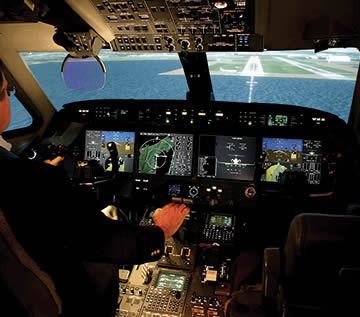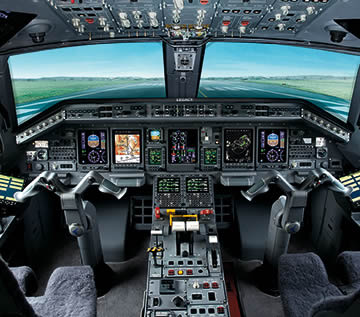|
With landing and taxiing being some of the most difficult situations for pilots, Honeywell Aerospace is working on new features to its Primus Epic integrated flight deck product line that
will keep pilots better informed and safer in the air and, more important, on the ground.
“You might think that once a pilot lands a plane after an eight-hour trip the workload decreases and the job gets easier, but that’s not always true,” said
Sandy Wyatt, test pilot with
Honeywell Aerospace Flight Test Operations. “At an unfamiliar airport and especially at night, pilots’ workload may dramatically increase once they land and turn off the runway and begin
to taxi. Time demands require getting to the gate expeditiously; onboard tools and electronic airport maps can greatly enhance a pilot’s situational awareness, thereby improving safety for
all the passengers.”
The new technology features include Honeywell’s 2-D and 3-D airport moving maps, Honeywell’s SmartView Synthetic Vision System with updates for lower landing minimums, cockpit
display of traffic information, and more.
| “Primus
Epic is one of the most advanced flight decks
available for business and commercial aircraft,
and these new features showcase that innovation
is at its best at Honeywell,” said
Brian Sill,
president, Business and General Aviation,
Honeywell Aerospace. “Honeywell created and
refined all of these features in its advanced
technologies labs and collaborated with numerous
aircraft manufacturers and pilots in test
flights to ensure the technology provides the
best user experience possible.” |
 |
| Primus Epic |
These features will provide
pilots with an enhanced and safer gate-to-gate experience and will be available
for all Primus Epic-supported platforms for certification as early as the next
two years.
Primus Epic Enhancements
-
Honeywell’s
SmartView Synthetic Vision: for Lower Landing Minimums. These updates
bring SmartView to the Primary Flight Display (PFD) and prepare aircraft
to take advantage of updated lower landing minimums, going from 200 to
150 feet.
-
2-D
and 3-D airport moving maps: The 2-D moving map shows runways, taxiways,
airport structures, and signs at many airports on the navigation
display, while the 3-D moving map upgrades the Synthetic Vision System
with an “out-the-window” view of the airport on the PFD.
-
Cockpit display of traffic information: This feature presents the position of nearby automatic dependent surveillance-broadcast (ADS-B) aircraft on the flight deck multifunction display,
giving the flight crew better awareness and understanding of airborne and surface traffic.
-
Touchscreen
controls: With an eight-inch diagonal screen, Primus Epic will support
touch for functions such as the flight management window, radio tuning,
flight planning, checklist, systems control and more.
-
Flight
deck connectivity: Wireless data loading can eliminate cost and effort
for implementing upgrades and updates. Pilots will benefit from an “always-up-to-date
flight deck” with full-featured graphical worldwide weather, real-time
updates of key layers on the navigation display, and just-in-time
delivery of relevant location specific information.
Primus Elite Enhancements
 |
| Primus Elite |
Honeywell’s Primus Elite flight deck, an LCD display upgrade for legacy SPZ-8400/8500 and Primus 1000/2000/2000XP flight decks, will introduce several new advanced features in late
2015:
-
Integrated Primary Flight Display with Synthetic Vision System: This will offer a more graphical and intuitive display for enhanced situation awareness.
-
XM Meteorological Aviation Report and Terminal Area Forecast: The enhanced map will be upgraded to provide more up-to-date weather information.
-
Traffic Collision Avoidance System: A new flight awareness layer will be added to the Enhanced Map feature.
-
On-wing field loading of application software and databases: This provides a significantly improved user experience, allowing all display units to be uploaded at the same time, without
removal, using the DL1000 and greatly reducing the total time required for data uploads.
|